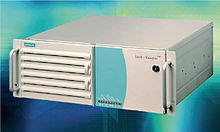Lock keeper
The lock-keeper is a patented implementation of the air gap concept for the physical and logical separation of computer network segments. Unlike a firewall , the system enforces network separation on the physical level ( OSI layer 1). Designed in the same way as a lock system, it alternately connects to one of the networks to be connected in order to record or make files or e-mails available.
Various transport, write and read restrictions have been implemented so that not just any data can be transferred. So the data z. B. checked by a virus scanner and, if necessary, subjected to further filtering and checks, for example direction of transmission, authenticity of the sender by checking the digital signature , recipient authenticity by encryption , file types or file size. The easily comprehensible mechanism implemented in hardware allows a controlled data transfer between two network segments, but at the same time ensures that there is never a direct online connection between these network segments. Usually, the system is not used instead of, but in combination with firewalls.
history
The Lock-Keeper was developed and patented by Christoph Meinel and his team since 1998 at the Institute for Telematics in Trier. After Meinel's move to the Hasso Plattner Institute at the University of Potsdam in September 2004, he and his team will from now on look after and develop the system there. Since July 2005 it has been licensed by the “Civil and National Security” division of Siemens Switzerland and brought to product maturity. Siemens sells the system worldwide; in Germany, the Lock-Keeper is available from Actisis GmbH.
swell
- Lock-Keeper Project
- Information from the HPI on the lock-keeper
- Actisis GmbH
